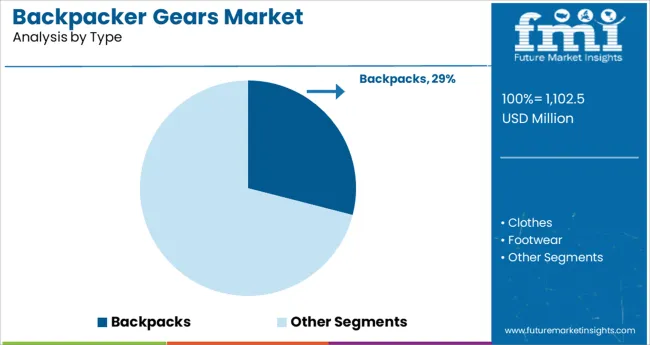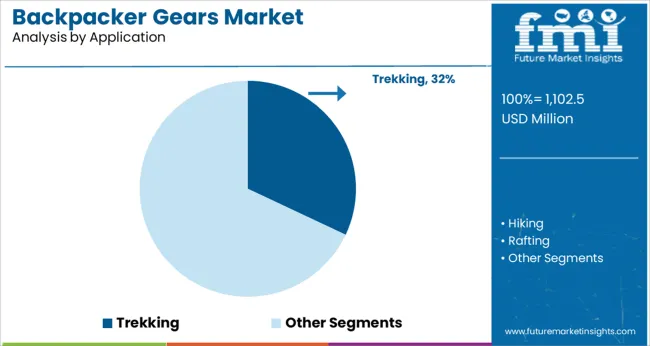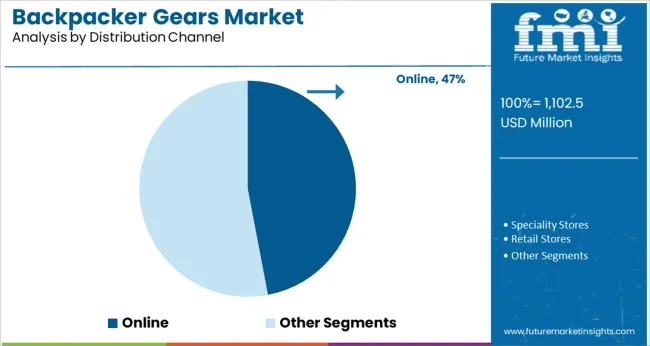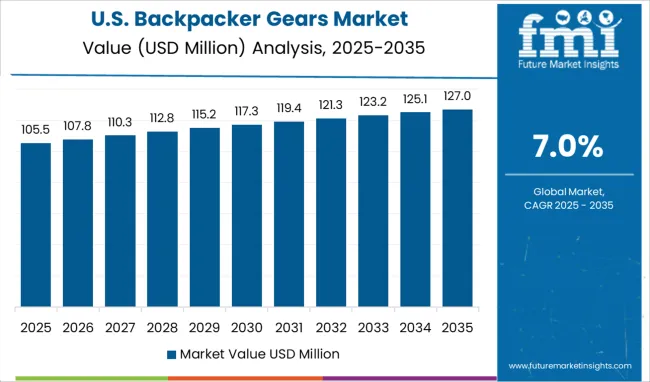The Backpacker Gears Market is estimated to be valued at USD 1,102.5 million in 2025 and is projected to reach USD 2,168.9 million by 2035, registering a compound annual growth rate (CAGR) of 7.0% over the forecast period.

The backpacker gears market is experiencing steady expansion, supported by rising global interest in hiking, trekking, and adventure travel. A cultural shift toward outdoor lifestyle experiences, combined with increasing participation in eco-tourism and solo travel, has amplified demand for versatile, durable, and ergonomic gear solutions.
The market is also being driven by advances in material science, enabling lightweight, weather-resistant, and modular gear suited for diverse terrains. Sustainability is emerging as a defining factor, as brands prioritize recycled fabrics and biodegradable coatings.
Digital communities and influencer-driven marketing are further catalyzing growth. In the coming years, expansion is expected across emerging economies through e-commerce and product innovation.
The market is segmented by Type, Application, Distribution Channel, Consumer Orientation, and Age Group and region. By Type, the market is divided into Backpacks, Clothes, Footwear, Equipment, and Others. In terms of Application, the market is classified into Trekking, Hiking, Rafting, Camping, Skiing, and Others (Biking, etc).
Based on Distribution Channel, the market is segmented into Online, Speciality Stores, and Retail Stores. By Consumer Orientation, the market is divided into Men, Women, and Children. By Age Group, the market is segmented into 26-35 Years, 15-25 Years, 36-45 Years, and 46-55 Years. Regionally, the market is classified into North America, Latin America, Western Europe, Eastern Europe, Balkan & Baltic Countries, Russia & Belarus, Central Asia, East Asia, South Asia & Pacific, and the Middle East & Africa.

Backpacks are projected to contribute 29.0% of the total revenue share in 2025. This is being driven by their multifunctional utility, ergonomic improvements, and demand for lightweight and weather-resistant designs. Advancements in modularity and compression are making backpacks ideal for both outdoor and urban crossover usage.

Trekking is expected to hold 32.0% of market share in 2025. Increased participation in fitness-based travel and eco-adventure experiences is driving demand. The need for gear that is durable, lightweight, and adaptable to multiple terrains is fueling the segment’s growth..

The online segment is projected to account for 47.0% of the total market revenue in 2025. Consumer reliance on e-commerce, along with digital-first brand strategies and influencer engagement, are accelerating online gear purchases. Product accessibility, comparison features, and direct-to-consumer models are strengthening this channel..
Travelers entail traveling to other towns, cities, mountains, or countries for various reasons. Nowadays there is a rising demand for adventure activities among the young generation. The generation wants to explore the environment, study nature, and also want to have fun. The increasing inclination towards ecological tours, health and lifestyle, and short recreational activities, are rising demands for backpack gear.
Since there is a rise in demand for such recreational activities various companies are taking initiatives to make innovative backpack gear by making it lightweight or combining it with technology or enhancing safety for the comfort and convenience of the traveler.
Social networking sites like Facebook, Twitter, and Instagram have widened the reach of promotions through online advertisements, enabled content providers to spread information via digital media, and enabled people to connect and fill gaps in their social networks.
In recent years various YouTubers have started promoting backpacking gears on their YouTube channels. Whereas, even various companies are collaborating with the leading social media travel influences for promoting or launching their products in the form of takeaways, or promotional events. The promoters attract consumers and this help to generate the demand for backpack gear among travelers.
The stress level of the global population has significantly increased over the last few years. The effect is taking place due to frequent changes in lifestyle habits due to workload, social and environmental impact, political landscape, and other crises.
Therefore, travelers participate in various outdoor activities such as hiking, trekking, camping, bike riding to take a break and rejuvenate their mental and physical health. Also, the various originations create awareness of stress relief tours and campaigns. Hence, increasing demand for physical and mental benefits and the rise in outdoor activates generate high demand for this backpack gears market.
Environmental Pioneer to Lead Backpack Gears Market with Eco-friendly Gears
Sweden is an environmental pioneer. Sweden is being on the top ten lists of the global environmental performance index for more than a decade. According to International Energy Agency (IEA), Sweden’s energy policy has set a goal for sustainability, being fossil-free, and making use of 100% renewable energy by 2045. The consumer in Sweden demand eco-friendly products.
Therefore, companies in Sweden are producing and promoting eco-friendly products on a big scale. For example, Fjällräven a Swedish company manufacturing backpack gears with eco-friendly and sustainable materials from recycled woo, organic hemp, and recycled polyester.
Green business practices are the backbone of the company's manufacturing process. As a result, various other businesses have begun to take the lead in developing sustainable bag pack items.

Appalachian Trails to Drive the Backpackers Market in America
America is the largest market for backpack gear and equipment. Consumers are indulging in more outdoor activities, and adventure activities to take a break from their daily busy schedule. The trend of experiencing Appalachian trails trek is attracting hikers for the activity of climbing a mountain.
According to the report published by Appalachian Trail Conservancy (ATC), the count of hikers attempting a climb from Georgia to Maine has doubled in 7 years from 1460 hikers in 2010 to 3735 climbers in 2020. Also, the Pacific Crest Trail (PCT) from Mexico to Canada covering California, Oregon, and Washington is attracting hikers. These events and its trend are driving the sales of the Backpackers Market in North America.
Footwear The Most Preferable Gear
According to the analysis, in terms of product type, there is more demand for footwear among travelers. The traveler intends to wear appropriate footwear during the trip. As a result, a traveler is more specific about things like quality, water resistance, comfort, and numerous factors. With an increase in tours and journeys, the need for footwear is also anticipated to increase.
Demand for the Gears Is Expected To Remain High Among Young and Middle Age Generation
In terms of age group, the number of tourists in the age bracket of 15-25 years and 26-35 years is expected to boost the market significantly, since this demographic is more inclined towards health and lifestyle, fitness, exploration, leisure, etc. and is more interested to study nature.
Hence more rises in trips and tours will generate more demand for backpack gear. Also, social media promotion may have an influential impact to buy this gear.
Hikers to Rise Backpack Gears Market
In terms of application, hiking is mostly preferred by tourists. People from all age groups love to do hiking. In recent years there is a growing attraction for treks in parts of Asia. With the rise of participants in hiking and events, there is a rise in demand for backpack gear. Also, there will be a rise in demand for technological advancement in the gears such as GPS backpacks, charging facilities, etc.

Leading players operating globally in the market are focusing on expansion in multiple equipment, accessories, and new innovative gear launches in order to expand their business globally.
For instance:
| Attribute | Details |
|---|---|
| Forecast Period | 2025 to 2035 |
| Historical Data Available for | 2020 to 2024 |
| Market Analysis | USD Million for Value |
| Key Regions Covered | North America; Latin America; Europe; East Asia; South Asia; Oceania & MEA |
| Key Countries Covered | United States of America, Canada, Brazil, Mexico, Argentina, Colombia Germany, The UK, France, Italy, Russia, South Africa, Turkey, UAE, Egypt, Jordan China, Japan, South Korea, India, Thailand, Malaysia, Indonesia, Philippines, Australia & New Zealand. |
| Key Segments Covered | Product Type, Application Type, Distribution Type, Consumer Orientation, Age Group, and Region. |
| Key Companies Profiled | VF Corporation (The North Face); Decathlon; Trek kit; Mountain Hardware; Black Diamond Equipments ltd.; Amer Sports; Newell Brands; Woodland; Mont-Bell Co. Ltd.; Rebook; Craghoppers; Wildcraft; Quechua; Columbia Sportsware Co.; Sierra Designs; Tatonka GmbH; ACE Cultural Tours; Outside Interactive, Inc.; Patagonia Inc. |
| Report Coverage | Market Forecast, Company Share Analysis, Competition Intelligence, Drivers, Restraints, Opportunities and Threats Analysis, Market Dynamics and Challenges, and Strategic Growth Initiatives |
| Customization & Pricing | Available upon Request |
The global backpacker gears market is estimated to be valued at USD 1,102.5 million in 2025.
It is projected to reach USD 2,168.9 million by 2035.
The market is expected to grow at a 7.0% CAGR between 2025 and 2035.
The key product types are backpacks, clothes, footwear, equipment and others.
trekking segment is expected to dominate with a 32.0% industry share in 2025.






Full Research Suite comprises of:
Market outlook & trends analysis
Interviews & case studies
Strategic recommendations
Vendor profiles & capabilities analysis
5-year forecasts
8 regions and 60+ country-level data splits
Market segment data splits
12 months of continuous data updates
DELIVERED AS:
PDF EXCEL ONLINE
Gears, Drives and Speed Changers Market Growth – Trends & Forecast 2025 to 2035
Plastic Gears Market Size and Share Forecast Outlook 2025 to 2035
Motocross Gears Market Outlook – Size, Share & Innovations 2025–2035
Market Share Distribution Among Motocross Gears Providers
Power Tool Gears Market - Growth & Demand 2025 to 2035
Railway Draft Gears Market Growth – Trends & Forecast 2025 to 2035
Gas Insulated Switchgears (GIS) Market
Data Center Automatic Transfer Switches and Switchgears Market Size and Share Forecast Outlook 2025 to 2035

Thank you!
You will receive an email from our Business Development Manager. Please be sure to check your SPAM/JUNK folder too.
Chat With
MaRIA